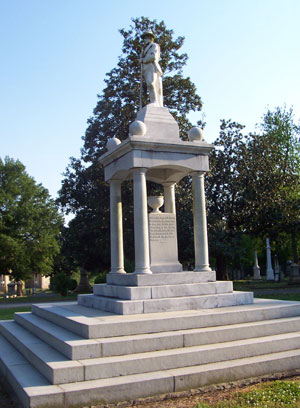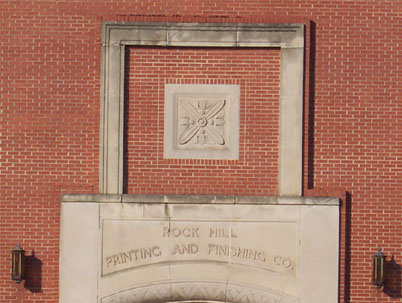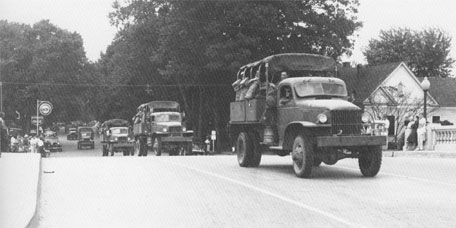Industrialization
In 1916, Anderson Buggy Company became the Anderson Motor Company,
and was contracted by the Government to make trucks and trailers for World War
I. By 1920, 35 automobiles a day were produced out of a 10-acre plant on Laurel
Street. Anderson cars were popular in Europe, sold in several colors unlike
Ford’s Model-T, was the first car to have headlight dimmers on the floorboard,
and boasted six cylinders and 50 MPH. After the economic slump in 1920, a smaller
and cheaper car was produced in 1922, but by 1925, the Anderson Motor Company
had been sold out to creditors.
 J.
M. Cherry donated a graded road on his vast farm to the City of Rock Hill in
1920 after being promised that a bridge would be built to cross the Catawba
in order to connect Rock Hill to other cities. Cherry Road became the first
concrete paved road in South Carolina. Before the end of the decade, Women voted
for the first time in 1920, Confederate Park was the first public park in Rock
Hill in 1924, street lights were installed along Oakland Avenue in 1925, East
Main Street was damaged by a tornado in 1926, the Andrew Jackson Hotel (known
today ad the Guardian Fidelity Building) opened in 1927, and Winthrop College
was the largest girl’s college in the south enrolling 1,800 students.
J.
M. Cherry donated a graded road on his vast farm to the City of Rock Hill in
1920 after being promised that a bridge would be built to cross the Catawba
in order to connect Rock Hill to other cities. Cherry Road became the first
concrete paved road in South Carolina. Before the end of the decade, Women voted
for the first time in 1920, Confederate Park was the first public park in Rock
Hill in 1924, street lights were installed along Oakland Avenue in 1925, East
Main Street was damaged by a tornado in 1926, the Andrew Jackson Hotel (known
today ad the Guardian Fidelity Building) opened in 1927, and Winthrop College
was the largest girl’s college in the south enrolling 1,800 students.
 In
1929, M. Lowenstein & Sons Company of New York bought
the Anderson Motor Company and converted it into
a cloth bleachery. The new operation was called The Rock Hill Printing and Finishing
Company. Within ten years, the Bleachery employed
1,850 workers. (At its height of business in the 1960’s, the Bleachery
employed over 4,800 people) During World War II, the Bleachery printed more
American Flags than any other plant in the world. After the 1960’s, the
plant steadily declined with the trend of textiles in America, until it became
a subsidiary of the Fort Mill based Springs Industries in 1985. By 1989, Springs
Industries disclosed intent to sell or close the Bleachery, and is presently
being considered with the rest of what is known as the
Textile Corridor for a renovation to bring in commercial businesses.
In
1929, M. Lowenstein & Sons Company of New York bought
the Anderson Motor Company and converted it into
a cloth bleachery. The new operation was called The Rock Hill Printing and Finishing
Company. Within ten years, the Bleachery employed
1,850 workers. (At its height of business in the 1960’s, the Bleachery
employed over 4,800 people) During World War II, the Bleachery printed more
American Flags than any other plant in the world. After the 1960’s, the
plant steadily declined with the trend of textiles in America, until it became
a subsidiary of the Fort Mill based Springs Industries in 1985. By 1989, Springs
Industries disclosed intent to sell or close the Bleachery, and is presently
being considered with the rest of what is known as the
Textile Corridor for a renovation to bring in commercial businesses.
In the 1930’s the American Legion Post #34 built a stadium
on Cherry Road, used today as Rock Hill School District #3 Stadium. Glencaren
Gardens was donated to the City of Rock Hill and is the focal point for the
city’s annual Come-See-Me festival held in the spring. A new post office
was dedicated December 1, 1932. York County Hospital in Ebenezer opened in 1940.
 Almost
2,400 Rock Hill Citizens served in the military in World War II. In 1941, the
military held maneuvers in and around the city of Rock Hill. Hundreds of soldiers
were guests of residents and enjoyed Saturday night dances. The Celanese Corporation
of America began construction of the Cel-River Plant on the east side of Cherry
Road on the southern banks of the Catawba River near Nations Ford on February
1st, 1947. By 1952, it was the largest acetate operation in the world. By the
end of the 1940’s, Rock Hill’s population was at or near 25,000
inhabitants.
Almost
2,400 Rock Hill Citizens served in the military in World War II. In 1941, the
military held maneuvers in and around the city of Rock Hill. Hundreds of soldiers
were guests of residents and enjoyed Saturday night dances. The Celanese Corporation
of America began construction of the Cel-River Plant on the east side of Cherry
Road on the southern banks of the Catawba River near Nations Ford on February
1st, 1947. By 1952, it was the largest acetate operation in the world. By the
end of the 1940’s, Rock Hill’s population was at or near 25,000
inhabitants.
In 1956, the British company Bowater agreed to build a large
pulp mill on the western bank of the Catawba River south of the railroad bridge
to Lancaster County.
Return
to Table of Contents
 J.
M. Cherry donated a graded road on his vast farm to the City of Rock Hill in
1920 after being promised that a bridge would be built to cross the Catawba
in order to connect Rock Hill to other cities. Cherry Road became the first
concrete paved road in South Carolina. Before the end of the decade, Women voted
for the first time in 1920, Confederate Park was the first public park in Rock
Hill in 1924, street lights were installed along Oakland Avenue in 1925, East
Main Street was damaged by a tornado in 1926, the Andrew Jackson Hotel (known
today ad the Guardian Fidelity Building) opened in 1927, and Winthrop College
was the largest girl’s college in the south enrolling 1,800 students.
J.
M. Cherry donated a graded road on his vast farm to the City of Rock Hill in
1920 after being promised that a bridge would be built to cross the Catawba
in order to connect Rock Hill to other cities. Cherry Road became the first
concrete paved road in South Carolina. Before the end of the decade, Women voted
for the first time in 1920, Confederate Park was the first public park in Rock
Hill in 1924, street lights were installed along Oakland Avenue in 1925, East
Main Street was damaged by a tornado in 1926, the Andrew Jackson Hotel (known
today ad the Guardian Fidelity Building) opened in 1927, and Winthrop College
was the largest girl’s college in the south enrolling 1,800 students. In
1929, M. Lowenstein & Sons Company of New York bought
the Anderson Motor Company and converted it into
a cloth bleachery. The new operation was called The Rock Hill Printing and Finishing
Company. Within ten years, the Bleachery employed
1,850 workers. (At its height of business in the 1960’s, the Bleachery
employed over 4,800 people) During World War II, the Bleachery printed more
American Flags than any other plant in the world. After the 1960’s, the
plant steadily declined with the trend of textiles in America, until it became
a subsidiary of the Fort Mill based Springs Industries in 1985. By 1989, Springs
Industries disclosed intent to sell or close the Bleachery, and is presently
being considered with the rest of what is known as the
Textile Corridor for a renovation to bring in commercial businesses.
In
1929, M. Lowenstein & Sons Company of New York bought
the Anderson Motor Company and converted it into
a cloth bleachery. The new operation was called The Rock Hill Printing and Finishing
Company. Within ten years, the Bleachery employed
1,850 workers. (At its height of business in the 1960’s, the Bleachery
employed over 4,800 people) During World War II, the Bleachery printed more
American Flags than any other plant in the world. After the 1960’s, the
plant steadily declined with the trend of textiles in America, until it became
a subsidiary of the Fort Mill based Springs Industries in 1985. By 1989, Springs
Industries disclosed intent to sell or close the Bleachery, and is presently
being considered with the rest of what is known as the
Textile Corridor for a renovation to bring in commercial businesses. Almost
2,400 Rock Hill Citizens served in the military in World War II. In 1941, the
military held maneuvers in and around the city of Rock Hill. Hundreds of soldiers
were guests of residents and enjoyed Saturday night dances. The Celanese Corporation
of America began construction of the Cel-River Plant on the east side of Cherry
Road on the southern banks of the Catawba River near Nations Ford on February
1st, 1947. By 1952, it was the largest acetate operation in the world. By the
end of the 1940’s, Rock Hill’s population was at or near 25,000
inhabitants.
Almost
2,400 Rock Hill Citizens served in the military in World War II. In 1941, the
military held maneuvers in and around the city of Rock Hill. Hundreds of soldiers
were guests of residents and enjoyed Saturday night dances. The Celanese Corporation
of America began construction of the Cel-River Plant on the east side of Cherry
Road on the southern banks of the Catawba River near Nations Ford on February
1st, 1947. By 1952, it was the largest acetate operation in the world. By the
end of the 1940’s, Rock Hill’s population was at or near 25,000
inhabitants.